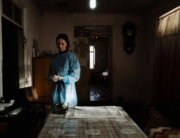Almost 25 years after her death, Diana, Princess of Wales, has become media fodder once again. The critically reviled musical Diana opened and recently closed on Broadway (you can hate-watch it on Netflix), and Kristen Stewart played the princess on a verge of a breakdown in 2021’s Spencer. On film or television, perhaps the gold standard biography depiction of Diana is in The Crown, which last season covered the Diana of the 1980s, from shy, blushing nanny to one of the most scrutinized women on earth.
Director Ed Perkins (Tell Me Who I Am) refreshingly takes a different tack than these other endeavors. He and his editors cover the princess’s life in the often harsh public spotlight by completely relying on contemporaneous audio and video news footage, from the time her name first appeared in tabloid headlines to her 1997 death in Paris. For those who bought copies of Vanity Fair and People back in the ‘90s when she and Prince Charles engaged in a tit-for-tat tabloid war as their marriage imploded, the film traces a familiar time line, and at a brisk pace.
Even without hindsight, the clips confirm the narrative that the couple never had a chance; Prince Charles often comes across as indifferent to his wife, at best. The visual compilation also becomes in some ways a highlight reel: her extravagant 1981 wedding; the couple’s 1983 tour of Australia, where she attracted massive crowds; and her humanitarian work. The Princess gives viewers a broader sense of the scale of her popularity, which The Crown, no matter how lavish its budget, could only hint at. Nearly all of the milestone photographs from Princess Diana’s time in the limelight flash on screen: her sitting alone in front of the Taj Mahal, her wowing the Reagan White House, and the telescopic paparazzi photos taken in the final year of her life.
Though the footage hits the milestones of Diana’s biography, it helps to be already familiar with it. The breakup of her parents’ marriage is only briefly mentioned, and there’s no hint of her cold feet on the onset of her wedding, at least in front of the cameras. A turning point in the princess’s relationship with the royal family is her infamous tell-all interview with Martin Bashir for the BBC Panorama program in the fall of 1995. There she reveals she believes she will never be queen, that she’s too much of a disruptor, (“I do things differently”). In a report released in 2021, and not mentioned here, the BBC publicly apologized for covering up the deceptive practices Bashir used to obtain the interview.
Occasionally, journalists, angry talk show audience members, and radio callers’ gibe at the princess, calling her a grandstander who enjoys the limelight and willingly upstages her husband and manipulates the media. Nevertheless, Perkins’s portrait is overwhelmingly sympathetic. Only a curmudgeon would smirk during its last 15 minutes, detailing her death and the national outpouring of grief. Here, any critical voices fall flat and come across as more than mean-spirited. Writer and naysayer Christopher Hitchens, seen interviewed near Buckingham Palace, disparages the princess’s legacy within feet of mourners, while one radio caller calls the massive outpouring of sympathy “gross idolatry.”
In lieu of bombshell revelations, this documentary offers small but telling moments that become their own story. On the day that Diana gives birth to Prince William, the heir to the throne, her sister-in-law, Princess Anne, irritably reacts to the news, apparently hearing it for the first time, while on a tour in New Mexico. And after Diana and Charles’s royal wedding, the newlyweds arrive at Buckingham Palace in a gleaming golden coach without speaking a word to each other. The glum prince hops out of the coach and strides inside while his bride poses for yet more photos for the ubiquitous photographers. It makes the deflated, speechless final moments of The Graduate seem celebratory.
The Princess will air later this year on HBO.







Leave A Comment